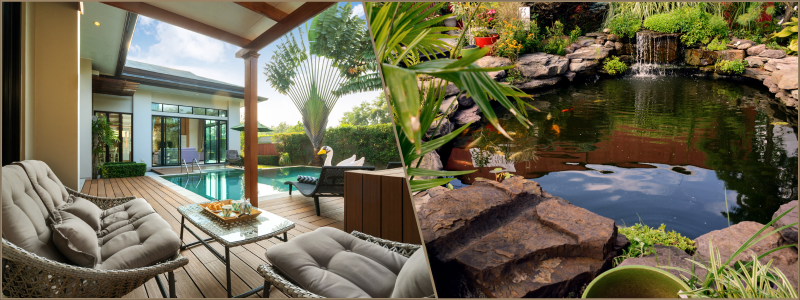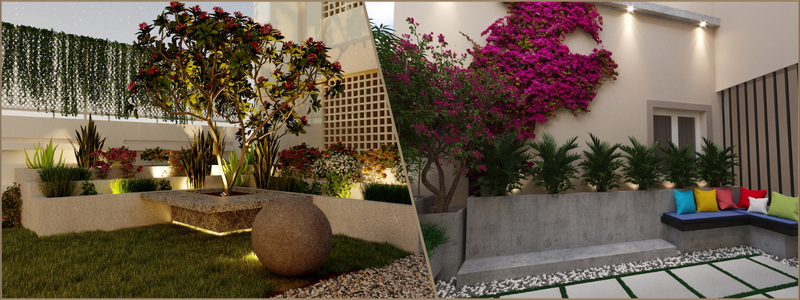Gardening has always been a favorite hobby among many enthusiasts. After all, nothing beats it in terms of being rewarding and therapeutic at the same time. Unfortunately, it also takes a lot of work. If you want to design the perfect garden, 3D landscape rendering services can help turn your visions into reality.
 Table of contents
Table of contents
- Popular landscape designs and styles
- Fundamental landscape design principles
- Common challenges in landscape design
- Limited budget
- Client expectations
- Weather and climate concerns
- Space limitations
- How Cad Crowd can help
Popular landscape designs and styles
At the start of your collaboration with a landscape designer, the first thing you have to do is decide on the landscape style you want. The following are some of the most popular landscape designs and ideas to choose from:
RELATED: Landscape design and visualization considerations for company landscape projects
Coastal landscape style
Airy and light designs best characterize the coastal landscape style. It focuses on salt-tolerant native plants that thrive in distinct coastal environments. The sandy paths are reminiscent of the beach. The hues of green and blue mimic the sky and the ocean. This rich combination forms a casual elegance that enhances the sense of relaxation while also celebrating the seashore and its undeniable beauty. A good tip here is to choose plants that can endure the air even if they have some salt in them. Choose decorations and colors that remind you of the tranquility of the seaside.
Modern landscape architecture
Modern landscape architecture creates a space that nurtures the combination of sophistication and simplicity. Think of uncluttered spaces and sleek lines that highlight functionality. The landscape architecture expert uses a neutral color palette to direct the spotlight to the architectural elements as well as the carefully handpicked plant life. Opt for a neutral palette, add contemporary materials such as glass and metal, and don’t hesitate to play with geometric patterns and shapes.
Traditional landscape design
Imagine a garden where all décor, paths, and plants are placed where they are intended. Think of neatly trimmed hedges, organized plantings, and manicured lawns. Color palettes are understated and refined. All elements are meticulously placed to achieve a cohesive and balanced look. Use classic shrubs and flowers, rustic or antique decorations, and symmetrical layouts to capture the evergreen style.
Xeriscaping
Xeriscaping is a sustainable smart landscape design approach tailored for drought-prone areas. Traditional lawns are replaced with artistic sweeps of stones and gravel. You can create a sustainable and visually appealing landscape that can thrive even during dry conditions if you choose native plants, place hardscape features strategically, and incorporate mulch or gravel. Your main focus should be drought-resistant native plants. Stones and gravel can also reduce your need for water.
Fundamental landscape design principles
The following are the core principles a 3D landscape designer adheres to in order to breathe life into their designs.
RELATED: Hire a landscaping architect for CAD drafting & design work
Symmetry and balance
Symmetry and balance play critical roles in producing a harmonious landscape design. Balance has two primary types – asymmetrical and symmetrical. Symmetrical balance creates mirrored or identical elements on both sides of the central point to achieve a sense of order and formality. Meanwhile, asymmetrical balance involves the arrangement of different elements that evenly distribute visual weight without being identical. Both types can be used to create balanced and visually pleasing landscapes. A good example of symmetrical balance is a sidewalk with both sides lined with matching shrubs.

Color theory in landscaping
The colors a 3D architectural rendering professional chooses can significantly impact the visual appeal and mood of any landscape. Warm colors like yellow, orange, and red create an energetic and vibrant atmosphere. Cool hues such as purple, green, and blue evoke a sense of tranquility and calm. Consider the contrasts, color combinations, and strategic placements of flowers and plants to produce a visually dynamic landscape. For instance, in a garden basking in the warm sun, combining cool-toned plants such as blue and lavender hydrangeas with marigolds in their warm tones can create a harmonious and vibrant color palette.
RELATED: Why landscape rendering and visualization is important for company landscaping projects
Focal points
Focal points are critical elements that give the landscape a sense of interest. These focal points, such as a well-designed seating area, a water feature, or a striking sculpture, serve as the visual anchor that guides the gaze of the viewer. Consider factors like placement, contrast, and scale in the landscape to make the focal points more effective. By highlighting and emphasizing the central elements, you can make the outdoor area more aesthetically appealing. Imagine a tranquil garden with a massive fire ring and a sunken conversation pit as its focal point.
Proportion and scale
Proportion and scale describe how different landscape elements relate to one another. It’s crucial to consider the mass, height, and size of the plants, hardscape features, and structures in the entire space. A pleasing visual balance can achieved if there is proper scaling and proportion of these elements. This prevents disproportionate arrangements or overcrowding that may detract from the design. See to it that larger plants or features don’t dwarf the focal points of a tiny garden.
Common challenges in landscape design
It’s common for landscape design services to encounter stumbling blocks during the process. The following are some of these challenges and how to overcome them:
RELATED: How landscape design services can help companies with 3D landscape design projects
Limited budget
It can be very challenging to work within a set budget. The good news is that there are a few tips to address these budget constraints.
1. Transparency and communication
From the start, landscape designers openly communicate with their clients about budget limitations. They should be upfront regarding possible cost implications and provide alternative recommendations that meet their requirements without exceeding the set budget.
2. Long-term planning
Many don’t realize that after some time, the initial project costs are cheaper than the maintenance costs. Landscape designers suggest low-maintenance landscapes and durable materials that can help their clients save more money down the road.
3. Prioritize vital elements
Architectural designers determine the design’s critical elements that align with the budget and goals of their clients. They then allocate additional resources to the focal points while looking for cheaper alternatives to not-so-essential features.
RELATED: What does it Cost to hire a landscape design architect expert for your company?

4. Value engineering
A landscape designer also looks for creative solutions to achieve the preferred outcome while cutting down costs. This may involve using more affordable materials that still offer the same aesthetic or designing in phases to distribute expenses.
Client expectations
Landscape designers know that managing client expectations requires a delicate balancing act. The following are some tips to ensure creativity and meet client needs.
1. Communication during the entire process
3D Rendering companies regularly communicate with clients to update them on the construction and design progress. They address any issues right away and clarify expectations and timelines.
2. Educate clients
A landscape designer also guides clients during the design process. They explain every reason behind their design recommendations, educate clients about challenges, and help them understand possibilities and limitations.
RELATED: The best landscape design rendering software available for architectural companies
3. Create a clear brief
Landscape designers start the design process with a thorough understanding of their clients’ desired outcomes, preferences, and vision. These details are documented to ensure that both parties are on the same page.
4. Present design ideas
Landscape designers develop various design concepts that showcase their creative ideas. They present these to clients and request their feedback. A collaborative approach is followed that merges their expertise with the client’s preferences. A good tip here is that rather than relying only on verbal explanations and the client’s imagination, 3D architectural visualization services can help showcase ideas. This helps prevent miscommunications throughout the planning stage.
Weather and climate concerns
Landscape designers address weather and climate concerns through the following strategies:
1. Drought-tolerant landscape
Landscape designers integrate xeriscaping methods and drought-tolerant plants to reduce water use. Proper irrigation systems and mulching can also help conserve water.
2. Research local climate
A landscape designer understands the region’s climate patterns, including precipitation levels, wind conditions, and temperature ranges.
3. Sun and shade considerations
Use the natural shade of structures and trees to create cozy outdoor areas. See, plants that need lots of sun won’t be under shade.
4. Wind-resistant features
The exterior rendering artist can also use trellises, walls, or hedges as windbreaks to protect the landscape from the strong winds.
Space limitations
Efficient planning and creativity are required to design limited or small outdoor areas. The following ideas can make the most out of small spaces.
RELATED: 3D Landscape design services: cost, rates, and pricing for companies and firms
1. Multipurpose elements
Integrate multifunctional design elements such as seating that also offers storage. Planters can also be dividers to form separate spaces in smaller gardens.
2. Optimize choices of plants
Choose plants suitable for small spaces, like dwarf or compact varieties. Container gardening is also a great option, as it allows you to reconfigure and move plants when necessary.
3. Strategic lights
Use lights to create additional space and attract attention to certain areas. The right lights can visually expand smaller outdoor spaces to make them feel more welcoming.
4. Vertical gardening
3D Visualization firms use vertical space by integrating hanging plants, living walls, and trellises. This adds greenery and creates visual interest while making the most of the available space.
How Cad Crowd can help
Cad Crowd is the leading resource for reliable 3D landscape rendering services, which can help you turn your dream gardens into reality!

